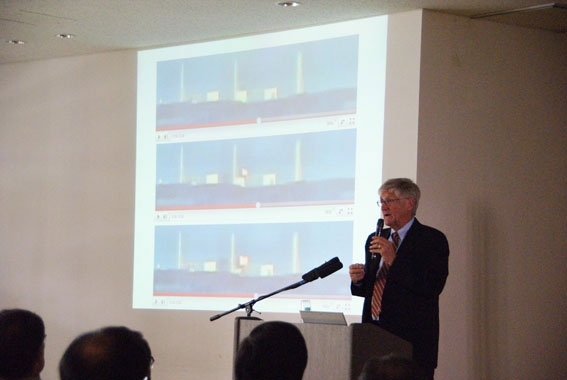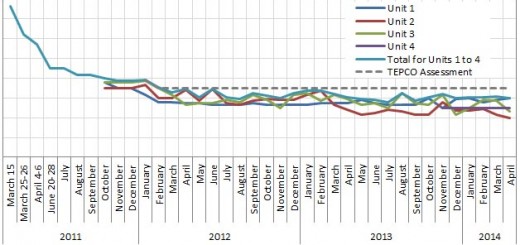International Symposium on the Truth of the Fukushima Nuclear Accident and the Myth of Nuclear Safety Nuke Info Tokyo No. 150
August 30 & 31, 2012 University of Tokyo, Komaba Campus
 |
|
Mr. Arnie Gundersen presenting at the Symposium
|
Purpose of the Symposium
The March 11, 2011 Tokyo Electric Power Company’s Fukushima Daiichi Nuclear Power Station accident is still ongoing, and radioactive material released from the Fukushima accident site continues to threaten people’s lives and the ecosystem. Moreover, the causes of the accident and its subsequent development have not yet been clarified. This symposium was planned with the purpose of getting as close to the truth of the Fukushima nuclear accident as is possible at this point in time from scientific and engineering viewpoints. In addition, the intention of the organizers was also to demonstrate how Japan’s nuclear power policies led to the occurrence of the accident. The government is rushing to restart nuclear power plants despite the fact that the streets are filled with talk of a nuclear phaseout in Japan. We believe that it is the great responsibility of scientists and engineers to reveal the reality of the Fukushima nuclear accident and to transmit to the world the outcome of the inspection of the evidence concerning the accident. We hope that this activity will make it possible to form a core of scientists and engineers that is capable of opposing the government and the corporations, and that this will lead on to further action in the future.
 |
|
Mr. Kotaro Kuroda presenting at the Symposium
|
Background to the Symposium
At the end of March, the co-sponsoring organizations* held a meeting to determine the outline of the planned symposium and the logistical preparations were pushed forward from that stage. The biggest problem was the number of seats in the auditorium. At first, a compact auditorium of 250 seats was prepared for the purpose of holding a gathering of scientists and engineers that would transmit their findings to the world. Since we wished to form a group of scientists that would be active after the symposium had taken place, we prepared a list of scientists and engineers we thought we would like to ask to take part in the Symposium and called on them to participate before taking advance reservations from the general public. When we did this, it turned out that many of the scientists and engineers were willing to attend and we soon found that this alone was likely to fill all available seats. Thus, on August 10, we quickly changed to a 400-seat auditorium, but were forced to end reservations the same day.
Around 380 people participated on the first day, and around 360 on the second day. Survey respondents numbered 71. Even for Session 5, three-minute declarations of resolutions by the co-sponsoring organizations, no one left the auditorium and we were very moved by the deep show of interest on the part of the participants.
Upcoming tasks are the preparation of the proceedings in bilingual English and Japanese, and we are also planning to produce for publication a video record of the symposium with English subtitles. We hope you will look forward to seeing these.
The email address for inquiries is <symposium@takagifund.org>
 |
|
Mr. Arnie Gundersen and Mr. Mitsuhiko Tanaka at the Symposium
|
* Co-sponsoring organizations
Group of Concerned Scientists and Engineers Calling for the Closure of the Kashiwazaki-Kariwa Nuclear Power Plant,
Citizens’ Nuclear Information Center (CNIC),
Research Center for Sustainable Development, Institute of Advanced Global Studies (IAGS), University of Tokyo,
Center for Development Research, Graduate Program on Human Security, University of Tokyo,
APAST (Union for Alternative Pathways in Science & Technology), The Takagi Fund for Citizen Science
■Program and Invited Speakers
Session 1: What Happened at the Fukushima Daiichi Nuclear Power Plant
Mitsuhiko Tanaka “Getting to the Bottom of the Fukushima Nuclear Accident: Didn’t the earthquake cause fatal damage to reactor facilities?”
Arnie Gundersen “What All Those Involved with Nuclear Power Must Learn from the Fukushima Daiichi Accident”
Katsuhiko Ishibashi “‘Fukushima Genpatsu Shinsai’ as an inevitable consequence of nuclear power plants in a seismic archipelago”
Session 2: Current Status of Radioactive Contamination
Tetsuji Imanaka “Radioactivity Release and Radioactive Contamination by the Fukushima Daiichi NPP Accident”
Session 3: Japan’s Nuclear Policy and Formation of the Safety Myth
Hitoshi Yoshioka“Aspects of ‘Public Policy Failure Disease’ on Fukushima Nuclear Disaster”
Philip White “‘Peaceful Use’ of Nuclear Energy and Nuclear Weapons Development”
Session 4: The State of Nuclear Science and Technology
Tetsuya Takahashi “A Sacrificial System – A Reflection on Responsibility”
Miranda Schreurs “The Ethics of Energy and the Responsibility of Scientists, Industry, Politicians, and Society: Experiences of the German Ethics Commission for a Safe Energy Supply”
Satoru Ikeuchi “Ethicality Problems of Nuclear Power Plants and the Social Responsibility of Scientists”
Session 5: Summing Up – from the Perspective of Scientists and Technologists

